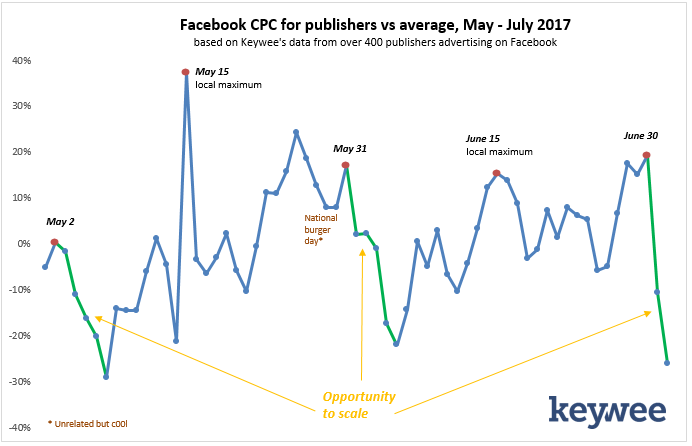If you’re a publisher using Facebook paid distribution to find engaged audiences for your content and bring them to your site, this week – the first week of the month – presents an opportunity for you. It’s a compelling opportunity, and admittedly not a rare one – it comes by every month.
Facebook CPC for publishers dips the first week of every month.
According to Keywee’s data, Facebook’s going advertising rates for content publishers – commonly known as CPC, or Cost Per Click – follow a cyclical pattern. Prices rise at the end of the month, peaking on the very last day, and dipping immediately afterwards for about a week. Hence, this first week represents an opportunity for publishers to scale their distribution in a cost effective way, essentially paying less for the same amount of clicks (and traffic).
The chart below illustrates this point.
How to read this:
Based on Keywee’s analysis of CPC data from over 400 publishers advertising on Facebook between May and July 2017, there is a week-long period of dip in CPC at the beginning of the month (marked by the green line). First week CPC can be 30% lower than the average CPC for this time frame, or 50% lower than its level just a few days earlier, at the very end of the month.
CPC during the first week of the month can be 50% lower than CPC on the last day of the month.
A similar phenomenon – though less pronounced – happens midway through the month. The 15th day of every month is a local maximum where CPC rises again, only to dip immediately afterwards.
Note: The same pattern was observed throughout 2017 and 2016. The chart was truncated for clarity.
The upshot? Scale on the first & third weeks of the month to get more bang for your $$
Every publisher promoting their content on Facebook should consider testing scaling their spend during the first week of the month, and to some extent, during the third week as well. Results may vary, but on average, CPC and overall cost during these times can be substantially lower than the average.


